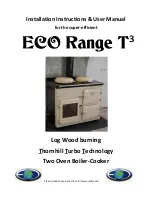
Instructions for use, installation and connection
56
Cleaning and maintenance
Never clean the appliance with pressurized hot steam cleaner!
Before cleaning switch the cooker off and let it cool down
completely.
Front side of the casing
For cleaning of frontal part of the cooker use the usual cleaning
agents and follow the manufacturer's instructions.
Never use any aggressive cleaning agents or dish cleaning
accessories which might cause scratches.
Stainless steel front
(certain models only)
Clean the surface with mild detergent (soap) and soft sponge
which does not scratch. Never use aggressive cleaners or
solvents, otherwise you may damage the surface.
Enamel coated and plastic surfaces
(certain models only)
Clean the knobs and handles with soft cloth and liquid
cleaners, intended for use of smooth enamel surfaces.
Glass ceramic hob
(certain models only)
Important
! Never use any aggressive detergents, like powder
detergents, rough dish sponges producing scratches, rust
removers or stain removers.
Cleaning after use
1
Clean the entire hob always when stained, preferably after
each use. Use soft cloth and
special cleansing agent
for ceramic hobs, and
follow the manufacturer's
instructions. Improper
cleansing agents may damage the
glass ceramic hob. Then wipe the hob surface dry
with
a clean and dry cloth or paper napkin.
Weekly care
2
Once a week clean the complete hob with the
special cleaning agents for glass ceramic hobs.
Strictly follow the instructions of the
manufacturer. These cleaning agents produce
protective film over the hob surface which acts
as a repellent for water and dirt. Any stains
remain upon the film and are easily removed
later. Then wipe the surface dry with a dry cloth.
Remains of cleaning agents may not be left
upon the glass ceramic surface, because they
are aggressive when heated and may damage
or discolor the surface.
Stubborn stains
Heavily soiled hob and stubborn stains (limestone, silver
gleam) may be best removed when the hob is still warm. Use
conventional detergents, and follow the instructions, described
in Section 2 above.
Spilled food must first be softened with damp cloth and
removed with special scraper for glass ceramic hobs. After
that, clean the surface as described in Section 2 above.
Melted sugar or plastics remove immediately ith the scraper,
albeit the ooktop is still hot. Then clean the surface as
described in Section 2 above.
Sand grits, accidentally spilled onto the surface when peeling
potatoes or cleaning lettuce, may produce scratches when pots
are moved about along the glass ceramic hob. Wipe any such
sand particles off the surface prior placing pots upon the hob.
Discoloration of the hob surface has no impact upon the
functionality of the appliance. It does not mean that the hob is
damaged, but merely represents burned out remains of food
and dirt.
Shining silvery spots are the consequence of moving the
dishes along the hob, especially in case of aluminum dishes, or
in case of inadequate cleaning agent. They are very difficult to
be removed by conventional cleaning agents, so you may
repeat the cleaning procedure several times. Use of aggressive
cleaners and rough dish bottoms produces abrasion and black
smudges upon the surface.
Oven
The oven may be cleaned in a traditional mode (using oven
cleaners and sprays). The following procedure is
recommended for regular cleaning of the oven (after each use):
Turn the mode selection button to the position
. Set the
temperature control button of the cold oven to 50°C. Pour 0,4 l
of water into the baking pan and insert it into the bottom grid
lead. After thirty minutes the food residues upon the enamel
coating are softened, and may be easily wiped off with a moist
cloth.
Otherwise respect the following cleaning tips:
•
Cool the oven completely before cleaning.
•
The oven and the accessories must be cleaned after each
use, otherwise stains might get burned in.
•
Oven walls, sprayed with oil from roasting, is best cleaned
with warm water and detergent when the oven is still tepid.
•
Hard and heavily stained oven should be cleaned with
special oven cleaning agents. Rinse the cleaner thoroughly
and remove any detergent remaining before the next use.
•
Never use aggressive cleaners, like polishing agents, dish
cleaning accessories, corrosion inhibitors, or any other
devices that might cause scratches.
•
Coated, stainless steel or zinc-coated surfaces or aluminum
parts must not come into contact with oven sprays, since
they might cause damage or discoloration. The same goes
for thermostat probe (if the cooker is equipped with it) and
exposed heaters on the oven ceiling.
•
When purchasing cleaning agents remember the
environment, and strictly follow the manufacturer's
instructions.
Removing wire grids
Wire guides may be removed to facilitate the cleaning of the
oven. Side grids are removed by swinging the bottom side
inwards and unhooking them from their place.
Clean the side grids only with conventional detergents.
To reinsert, repeat the procedure backwards: slide them into
the holes and swing downwards.
Removing oven door
(certain models only)
Open the door to the horizontal position. Pull the bottom hinge
supports upwards to the vertical position and lock them to the latch
of upper hinge support. Close the door halfway (see fig.) and pull it
out. For reinserting the door repeat the procedure backwards. Insert
the door in half open position (at an angle of 60
°
) by pushing them
all the way in during opening. Be sure that the notches on bottom
hinge carriers fit exactly the oven floor. Now open the door
completely, remove the hinge clamps from the upper hinge latches
and return them into the horizontal position.
1
door hinge in
2
door hinge during
operating position
dismantling
Содержание PF6064RVSUU/P1
Страница 61: ...N vod k pou it 1...
Страница 62: ...N vod k pou it 1...
Страница 63: ......
Страница 64: ...E44U3 E34 PELGRIM 129384 49 05 07...









































